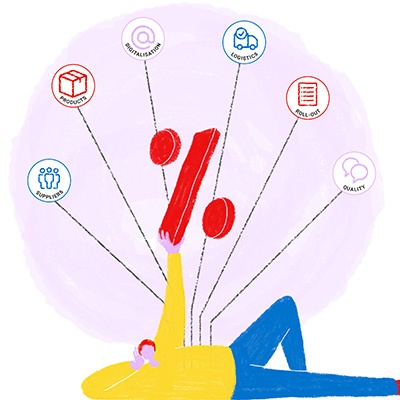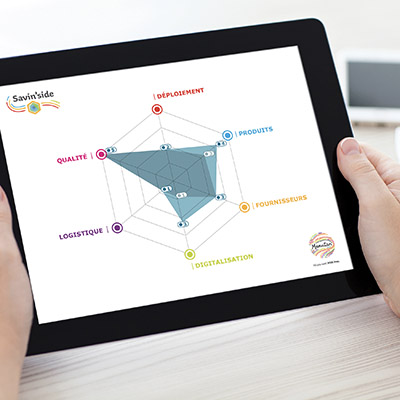In an increasingly unpredictable world, one crisis follows another: Geopolitical instability, cyberattacks, natural disasters, public health emergencies like the Covid-19 pandemic… These events can unsettle businesses of all sizes and sectors. Therefore, it’s imperative to ensure business continuity, protect employees, and maintain product and/or service delivery to customers. This is where business resilience comes into play and procurement departments have a major role in this area.
What is business resilience?
Business resilience refers to any company’s ability to respond to major or consequential events and to continue operating during those crises. To achieve this, the company must prepare and integrate these possibilities into its operations at all levels.
The key challenge of business resilience consists of quickly managing three key phases:
- Responding to a crisis;
- Recovering from its consequences;
- Capitalising on its lessons.
Of course, there is no “standard” approach to dealing with these undesirable events. It relies more on agile, evolving, and integrated approaches.
Business resilience particularly relies on a solid crisis management plan, as is the case at Manutan. This is a reference document that details how the company plans to respond to and recover from a crisis. This includes the functioning of the crisis management unit, the alert and activation process, etc.
However, the business resilience strategy goes well beyond a crisis management or business continuity plan, as it ensures long-term sustainability. As General François Vernoux emphasises in his latest work: "To achieve business resilience, your crisis management must be able to seamlessly substitute for failed risk management. Plan to reduce the unexpected and prepare for the unpredictable to remain sustainable." The experts at McKinsey & Company add: "Resilience is not just about the ability to recover quickly. In business, resilience is about facing adversity and shocks and continuously adapting to grow. Truly resilient organisations don’t just bounce back better; in fact, they thrive in hostile environments."
Moreover, identifying risks, understanding them, and managing them opens up new opportunities. It’s a chance for companies to gain new market share, strengthen stakeholder trust, make strategic acquisitions, assess new products and/or services…
Lastly, certain sectors are subject to specific regulations in this area. This is the case for financial services with the European DORA (Digital Operational Resilience Act) regulation, which aims to strengthen the cyber resilience of the sector, particularly against cyberattack risks.
-
Supply chain
-
Environment
-
Cybersecurity and technology
-
Talent
-
Regulations
-
Inflation
-
Operational infrastructure
-
Financial management
The role of procurement in business resilience
Because they are at the heart of the ecosystem, procurement departments play a major role in supporting the business resilience and, particularly, supply chain resilience. To achieve this, they have multiple levers, ranging from risk management to digital transformation.
Risk management
Supply chains are increasingly complex and extensive. This is why procurement must have a good understanding and total visibility of all stages – and all players – in the supply chain to mitigate the risks and potential for disruption inherent in such diverse networks.
In this configuration, it’s interesting to integrate suppliers beyond Tier 1. This involves leveraging data and analytics to understand potential impacts on your business and transform them into early warning systems. Thanks to artificial intelligence (AI), it’s now possible to predict future disruptions, optimise processes, and make informed decisions in real time.
Spend management
Spend management also plays a key role in risk mitigation. It helps maintain cash flow during periods of disruption and facilitate business disaster recovery.
Digital tools are key to achieving complete spend visibility. This includes Procure-to-Pay solutions, but also advanced spend analysis technologies integrated into corporate information systems. Another point not to be neglected is the control of maverick spend, which tends to fly under procurement departments’ radar.
Savings optimisation
The procurement function has always had cost reduction as its historical mission. Depending on different business strategies, it has sometimes been relegated to the background. But in times of crisis, it’s not uncommon to see savings objectives return to the forefront.
This has a positive impact on corporate cash flow to maintain activities. To achieve this, procurement has several tools in its arsenal:
- Optimising sourcing strategies;
- Leveraging strategic relationships with partners;
- Better monitoring supplier performance…
Supplier relationship management
During a crisis, the relationships a business maintains with its suppliers play a decisive role. Building a solid network of trusted suppliers, based on transparency, communication, and performance, constitutes an undeniable advantage for business resilience.
This involves having detailed knowledge of your supplier portfolio to strengthen risk management, but also collaboration with strategic partners. In this dynamic, procurement teams have every interest in becoming their suppliers’ "favourite" customer.
Digitalisation deployment
Today, companies equipped with digital tools (Procure-to-Pay or e-procurement solutions) have a clear advantage in maintaining their activity flows during disruptions. This is particularly true when it also involves remote working.
This is why it’s crucial to digitalise and, as much as possible, automate procurement processes to accelerate cycles and maximise autonomy. It’s also important to focus on technologies that integrate with all business functions (procurement, but also finance, sales, legal…) to promote communication, collaboration, and data sharing.
In the current economic and sociopolitical context, business resilience is no longer optional. By adopting this approach, companies are able to overcome crises and emerge stronger. It allows them to significantly reduce risks, ensure operational continuity in case of disruption, but also and especially to obtain a sustainable competitive advantage. This is how we transform each crisis into an opportunity for growth and innovation.
[1] Deloitte, One size doesn’t fit all - Four postures toward resilience, 2023









